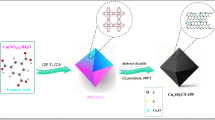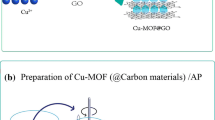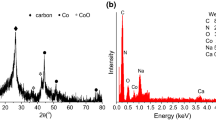Abstract
The novel synthesis of carbon-supported metal catalysts was completely developed by using electroplating technique. A carbon support was prepared from cattail (Typha angustifolia) flowers (CF) as a bio-material precursor through a hydrothermal process combined carbonization. The prepared carbons exhibited a high surface area, porosity, and excellent electrical conductivity, which is relevant characteristics to materials utilized for metal catalyst supporter. In this study, electroplating technique has been applied for the catalyst synthesis to utilize in hydrogenation of methyl levulinate to γ-valerolactone. Interesting experimental parameters in electroplating such as metal precursors (Ni and Cu), solution temperatures (40, 45, 50, 55, and 60 °C), and applied voltages (3.0, 3.5. 4.0, 4.5, and 5.0 V) were thoroughly investigated on some characteristics of catalysts. The physicochemical properties of studied catalysts were comprehensively characterized by using high-resolution scanning electron microscopy (HRSEM) equipped with energy dispersive spectroscopy (EDS) and focused ion beam (FIB), X-ray diffraction (XRD), and nitrogen sorption analyzer to examine surface morphology, elemental compositions, distribution of the metal in cross-section surface, crystallinity, and textural pore characteristic, respectively. In electroplating process, the solution temperature of 50 °C with the applied voltage of 4 V become an optimal condition for the synthesis of catalyst with uniformed metallic phase and high metal dispersion on carbon support. Ni-carbon and Cu-carbon catalysts exhibited an excellent catalytic activity with the methyl levulinate conversion of 32.68% and 29.17%, respectively.













Similar content being viewed by others
References
Balat M, Balat H (2009) Recent trends in global production and utilization of bio-ethanol fuel. Appl Energy 86:2273–2282
Demirbas A (2005) Biodiesel production from vegetable oils via catalytic and non-catalytic supercritical methanol transesterification methods. Prog Energy Combust Sci 31:466–487
Nisar J, Razaq R, Farooq M, Iqbal M, Khan RA, Sayed M, Shah A, Rahman IU (2017) Enhanced biodiesel production from Jatropha oil using calcined waste animal bones as catalyst. Renewable Energy 101:111–119
Zhao C, Lv P, Yang L, Xing S, Luo W, Wang Z (2018) Biodiesel synthesis over biochar-based catalyst from biomass waste pomelo peel. Energy Convers Manage 160:477–485
Numwong N, Luengnaruemitchai A, Chollacoop N, Yoshimura Y (2012) Effect of SiO2 pore size on partial hydrogenation of rapeseed oil-derived FAMEs. Appl Catal A 441–442:72–78
Papadopoulos CE, Lazaridou A, Koutsoumba A, Kokkinos N, Christoforidis A, Nikolaou N (2010) Optimization of cotton seed biodiesel quality (critical properties) through modification of its FAME composition by highly selective homogeneous hydrogenation. Bioresour Technol 101:1812–1819
Horváth IT, Mehdi H, Fábos V, Boda L, Mika LT (2008) γ-Valerolactone—a sustainable liquid for energy and carbon-based chemicals. Green Chem 10:238–242
Lin Z, Cai X, Fu Y, Zhu W, Zhang F (2017) Cascade catalytic hydrogenation–cyclization of methyl levulinate to form γ-valerolactone over Ru nanoparticles supported on a sulfonic acid-functionalized UiO-66 catalyst. RSC Adv 7:44082–44088
Ruppert AM, Grams J, Jedrzejczyk M, Matras-Michalska J, Keller N, Ostojska K, Sautet P (2015) Titania-supported catalysts for levulinic acid hydrogenation: influence of support and its impact on gamma-valerolactone yield. Chemsuschem 8:1538–1547
Sudhakar M, Kumar VV, Naresh G, Kantam ML, Bhargava SK, Venugopal A (2016) Vapor phase hydrogenation of aqueous levulinic acid over hydroxyapatite supported metal (M = Pd, Pt, Ru, Cu, Ni) catalysts. Appl Catal B 180:113–120
Wei Z, Li X, Deng J, Wang J, Li H, Wang Y (2018) Improved catalytic activity and stability for hydrogenation of levulinic acid by Ru/N-doped hierarchically porous carbon, Molecular. Catalysis 448:100–107
Funkenbusch LT, Mullins ME, Salam MA, Creaser D, Olsson L (2019) Catalytic hydrotreatment of pyrolysis oil phenolic compounds over Pt/Al2O3 and Pd/C. Fuel 243:441–448
H-S Lee, H Seo, D Kim, Y-W Lee (2020) One-pot supercritical transesterification and partial hydrogenation of soybean oil in the presence of Pd/Al2O3 or Cu or Ni catalyst without H2, The Journal of Supercritical Fluids, 156
Li C, Xu G, Zhai Y, Liu X, Ma Y, Zhang Y (2017) Hydrogenation of biomass-derived ethyl levulinate into γ-valerolactone by activated carbon supported bimetallic Ni and Fe catalysts. Fuel 203:23–31
Li YY, Yu SL, Shen WY, Gao JX (2015) Iron-, cobalt-, and nickel-catalyzed asymmetric transfer hydrogenation and asymmetric hydrogenation of ketones. Acc Chem Res 48:2587–2598
Zhou M, Li J, Wang K, Xia H, Xu J, Jiang J (2017) Selective conversion of furfural to cyclopentanone over CNT-supported Cu based catalysts: model reaction for upgrading of bio-oil. Fuel 202:1–11
X Feng, Y Tian, L Xiao, W Wu (2020) Fe–Mo2C: a magnetically recoverable catalyst for hydrogenation of ethyl levulinate into γ-valerolactone, Catalysis Letters 150:2027–2037
Gowda RR, Chen EY (2016) Recyclable earth-abundant metal nanoparticle catalysts for selective transfer hydrogenation of levulinic acid to produce gamma-valerolactone. Chemsuschem 9:181–185
Quiroz J, Mai EF, Teixeira da Silva V (2015) Synthesis of nanostructured molybdenum carbide as catalyst for the hydrogenation of levulinic acid to γ-valerolactone. Top Catal 59:148–158
Xu Q, Li X, Pan T, Yu C, Deng J, Guo Q, Fu Y (2016) Supported copper catalysts for highly efficient hydrogenation of biomass-derived levulinic acid and γ-valerolactone. Green Chem 18:1287–1294
Alzaid A, Wiens J, Adjaye J, Smith KJ (2018) Impact of molecular structure on the hydrogenation and oligomerization of diolefins over a Ni-Mo-S/γ-Al2O3 catalyst. Fuel 221:206–215
He Y, Yan L, Liu Y, Liu Y, Bai Y, Wang J, Li F (2019) Effect of SiO2/Al2O3 ratios of HZSM-5 zeolites on the formation of light aromatics during lignite pyrolysis. Fuel Process Technol 188:70–78
Lam SS, Liew RK, Wong YM, Azwar E, Jusoh A, Wahi R (2016) Activated carbon for catalyst support from microwave pyrolysis of orange peel. Waste and Biomass Valorization 8:2109–2119
Yang Y, Sun C-J, Brown DE, Zhang L, Yang F, Zhao H, Wang Y, Ma X, Zhang X, Ren Y (2016) A smart strategy to fabricate Ru nanoparticle inserted porous carbon nanofibers as highly efficient levulinic acid hydrogenation catalysts. Green Chem 18:3558–3566
Zhang T, Li W, Xu Z, Liu Q, Ma Q, Jameel H, Chang HM, Ma L (2016) Catalytic conversion of xylose and corn stalk into furfural over carbon solid acid catalyst in gamma-valerolactone. Bioresour Technol 209:108–114
Pinto BP, Fortuna ALL, Cardoso CP, Mota CJA (2017) Hydrogenation of levulinic acid (LA) to γ-valerolactone (GVL) over Ni–Mo/C catalysts and water-soluble solvent systems. Catal Lett 147:751–757
ET Sayed, H Alawadhi, K Elsaid, AG Olabi, M Adel, Almakrani, ST Bin Tamim GHM, Alafranji, MA Abdelkareem (2020) A carbon-cloth anode electroplated with iron nanostructure for microbial fuel cell operated with real wastewater. Sustainability 12:2–11
J Huang, M Chen, T Tang, W Liu, Y Liu (2020) Electroplated synthesis of semi-rigid MoS2–rGO–Cu as efficient self-supporting electrode for hydrogen evolution reaction. Electrochimica Acta 355:136754
Jang K-H, Lee S-H, Han Y, Yoon S-H, Lee C-S (2016) Synthesis and characteristics of silica-coated carbon nanofibers on electroplated Co–Ni/C-fiber textiles. J Nanosci Nanotechnol 16:10767–10771
Eshghi A, Kheirmand M (2018) Electroplating of Pt–Ni–Cu nanoparticles on glassy carbon electrode for glucose electro-oxidation process. Surface Engineering 35:128–134
Bai C-X, Shen F, Qi X-H (2017) Preparation of porous carbon directly from hydrothermal carbonization of fructose and phloroglucinol for adsorption of tetracycline. Chin Chem Lett 28:960–962
Xiao P-W, Meng Q, Zhao L, Li J-J, Wei Z, Han B-H (2017) Biomass-derived flexible porous carbon materials and their applications in supercapacitor and gas adsorption. Mater Des 129:164–172
Cai F, Jiang C, Wu X (2014) X-ray diffraction characterization of electrodeposited Ni–Al composite coatings prepared at different current densities. J Alloy Compd 604:292–297
Maharana HS, Bishoyi B, Basu A (2019) Current density dependent microstructure and texture evolution and related effects on properties of electrodeposited Ni-Al coating. J Alloy Compd 787:483–494
Thiagarajan S, Thaiyan M, Ganesan R (2016) Physical vapor deposited highly oriented V2O5 thin films for electrocatalytic oxidation of hydrazine. RSC Adv 6:82581–82590
Vogel YB, Darwish N, Kashi MB, Gooding JJ, Ciampi S (2017) Hydrogen evolution during the electrodeposition of gold nanoparticles at Si(100) photoelectrodes impairs the analysis of current-time transients. Electrochim Acta 247:200–206
Góral A (2017) Nanoscale structural defects in electrodeposited Ni/Al 2 O 3 composite coatings. Surf Coat Technol 319:23–32
Wang Z, Liu J, Qin C, Yu H, Xia X, Wang C, Zhang Y, Hu Q, Zhao W (2015) Dealloying of Cu-based metallic glasses in acidic solutions: products and energy storage applications. Nanomaterials (Basel) 5:697–721
Wasekar NP, Haridoss P, Seshadri SK, Sundararajan G (2016) Influence of mode of electrodeposition, current density and saccharin on the microstructure and hardness of electrodeposited nanocrystalline nickel coatings. Surf Coat Technol 291:130–140
Wang X, Zeng W, Hong L, Xu W, Yang H, Wang F, Duan H, Tang M, Jiang H (2018) Stress-driven lithium dendrite growth mechanism and dendrite mitigation by electroplating on soft substrates, Nature. Energy 3:227–235
Xu S, Yu D, Ye T, Tian P (2017) Catalytic transfer hydrogenation of levulinic acid to γ-valerolactone over a bifunctional tin catalyst. RSC Adv 7:1026–1031
Bui L, Luo H, Gunther WR, Román-Leshkov Y (2013) Domino reaction catalyzed by zeolites with Brønsted and Lewis acid sites for the production of γ-valerolactone from furfural. Angew Chem 125:8180–8183
N Lázaro, A Franco, W Ouyang, A Balu, A Romero, R Luque, A Pineda (2019) Continuous-flow hydrogenation of methyl levulinate promoted by Zr-based mesoporous materials. Catalysts 9:1–13
Gong W, Chen C, Fan R, Zhang H, Wang G, Zhao H (2018) Transfer-hydrogenation of furfural and levulinic acid over supported copper catalyst. Fuel 231:165–171
Tanwongwan W, Eiad-ua A, Kraithong W, Viriya-empikul N, Suttisintong K, Klamchuen A, Kasamechonchung P, Khemthong P, Faungnawakij K, Kuboon S (2019) Simultaneous activation of copper mixed metal oxide catalysts in alcohols for gamma-valerolactone production from methyl levulinate. Appl Catal A 579:91–98
Author information
Authors and Affiliations
Corresponding author
Additional information
Publisher's Note
Springer Nature remains neutral with regard to jurisdictional claims in published maps and institutional affiliations.
Rights and permissions
About this article
Cite this article
Kaewtrakulchai, N., Gunpum, W., Fuji, M. et al. Cattail (Typha angustifolia) flower-derived porous carbons as support of electroplated Ni and Cu catalysts for hydrogenation of methyl levulinate to γ-valerolactone. Biomass Conv. Bioref. 13, 12631–12641 (2023). https://doi.org/10.1007/s13399-021-02038-z
Received:
Revised:
Accepted:
Published:
Issue Date:
DOI: https://doi.org/10.1007/s13399-021-02038-z




